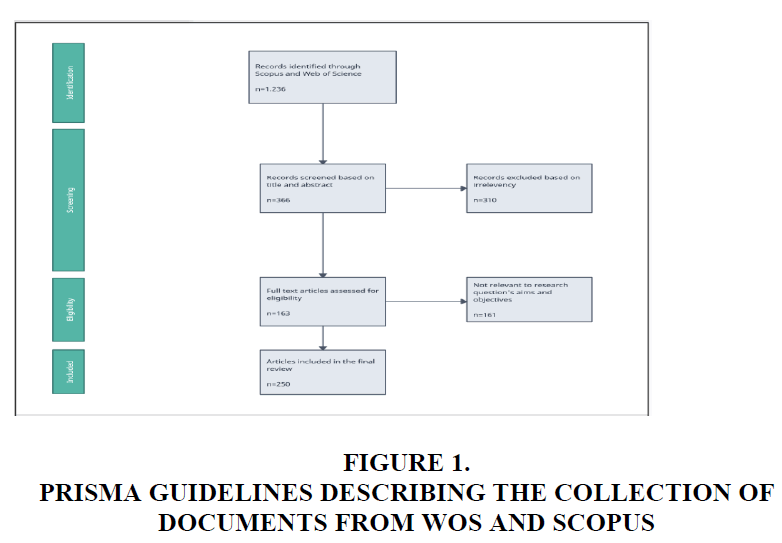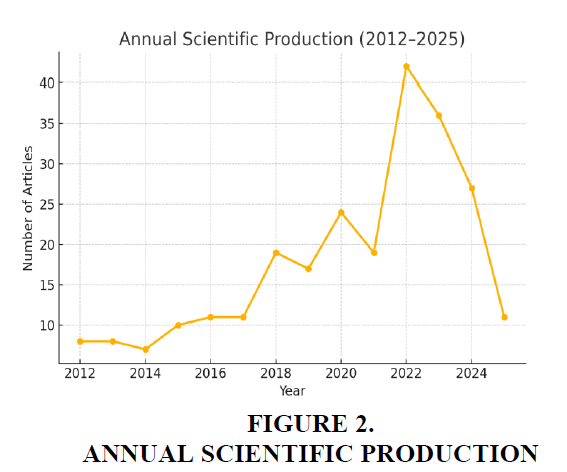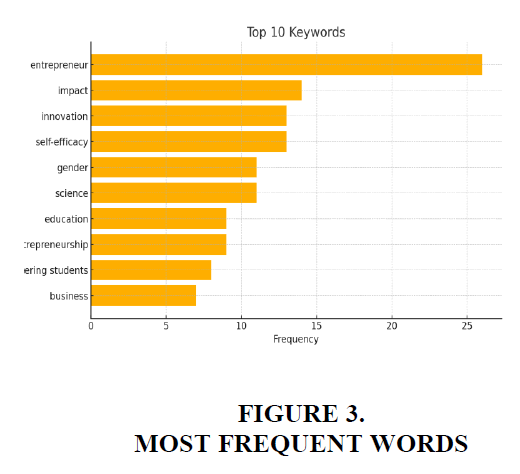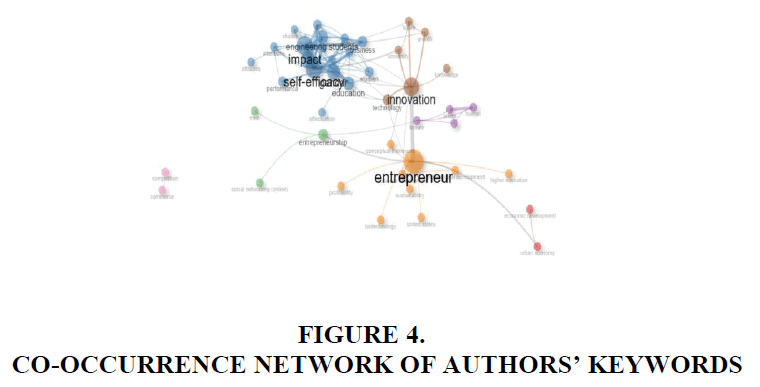Research Article: 2025 Vol: 28 Issue: 2S
Bibliometric Analysis of Integrating Entrepreneurial Education into STEM Education
SECIL AKSOY, Faculty at Near East University (NEU),Cyprus
Citation Information: Tuan Anh, P., (2025). Evaluate the Effectiveness of Scientific Research Activities Based on Intercultural Education Theory for Social Sciences at Local Public Universities. Journal of Entrepreneurship Education, 28(1), 1-11.
Abstract
This study presents a bibliometric analysis of 250 articles published between 2012 and 2025 on the integration of entrepreneurial education into STEM disciplines. Using data from Web of Science and Scopus, analyzed through Bibliometrix, the study identifies key trends, leading sources, and thematic developments. Findings show steady growth in output, with major contributions from journals like the International Entrepreneurship and Management Journal and authors such as Raposo, Treanor, and Yordanova. Core themes include “entrepreneurship,” “impact,” “innovation,” and “self-efficacy.” The United States and China lead in both publication volume and citation impact. Thematic shifts point to a growing focus on applied, technology-enhanced models incorporating AI and learner-centered approaches. This analysis offers insights for advancing innovation-focused STEM education through entrepreneurship.
Keywords
Bibliometric Analysis, Entrepreneurial Education, STEM, Innovation, Research Trends.
Introduction
Entrepreneurial education refers to structured educational approaches designed to cultivate entrepreneurial mindsets, skills, and behaviors in learners. These programs aim not only to foster the creation of new businesses but also to instill competencies such as opportunity recognition, risk management, innovation, creativity, leadership, resilience, and problem-solving (Bacigalupo et al., 2016; European Commission, 2015). At its core, entrepreneurial education seeks to empower individuals to think critically, act autonomously, and contribute meaningfully to economic and societal development, whether as business founders, innovators within organizations, or socially responsible change agents (Neck & Corbett, 2018).
In the context of 21st-century education, entrepreneurial education has become increasingly relevant across disciplines. Its integration into Science, Technology, Engineering, and Mathematics (STEM) education is particularly vital, as STEM fields already emphasize technical knowledge and logical reasoning. However, without complementary entrepreneurial skills, STEM graduates may lack the ability to translate their technical expertise into innovative, real-world solutions (Gibb, 2002; Neck & Corbett, 2018). Embedding entrepreneurial education within STEM curricula equips students with both the cognitive tools of science and engineering and the adaptive capacities required for navigating complex, innovation-driven environments (Mason & Brown, 2014).
As global economies pivot toward knowledge-intensive and innovation-based growth models, the labor market increasingly demands professionals who can operate across disciplinary boundaries and initiate value-creating projects. The Organisation for Economic Co-operation and Development (OECD, 2019) emphasizes that tomorrow's workforce will require a blend of technical proficiency, creative thinking, and entrepreneurial initiative. In this context, integrating entrepreneurship into STEM education is not just an educational innovation but a strategic imperative for societal and economic resilience (Fayolle & Gailly, 2015).
Educational institutions have responded to this need by developing various models for combining entrepreneurship with STEM. These include project-based learning frameworks, interdisciplinary capstone courses, startup incubator integration, and experiential learning strategies where students simulate business development or engage with real-world problems (Byers et al., 2013; Rasmussen & Wright, 2015). While these approaches are gaining traction, the global research landscape on this topic remains fragmented and dispersed across multiple disciplines, lacking cohesive overviews or consolidated evaluation frameworks.
To address this gap, the present study employs a bibliometric analysis of 250 academic articles published between 2012 and 2025—drawn from both the Web of Science (WoS) and Scopus databases. Through quantitative mapping and network-based insights, the study seeks to uncover key publication trends, leading contributors, thematic developments, and collaboration patterns in the intersection of entrepreneurial education and STEM. The following research questions (RQs) guide this analysis:
RQ1. What are the publication trends and annual scientific production rates related to entrepreneurial education in STEM?
RQ2. Which countries, institutions, and authors are the most prolific and influential in this field?
RQ3. What are the most frequently discussed keywords and thematic areas within the literature?
RQ4. How has the thematic structure of this research evolved over time, particularly in relation to educational technologies and learner-centered approaches?
RQ5. Which journals and sources are most central to disseminating research on this topic?
RQ6. What collaboration patterns exist among authors and countries, and how internationally connected is this research landscape?
RQ7. What are the most globally cited documents, and what themes do they represent?
By addressing these questions, this study offers a data-driven overview of the academic development of entrepreneurial-STEM education and provides insights for researchers, policymakers, and educators seeking to shape future pedagogical models that are both innovative and impactful.
Methodology
In this research, Web of Science (WoS) and Scopus were selected as the primary database, and a bibliometric analysis was conducted to examine the integration of entrepreneurial education into STEM education. The study analyzed journal articles published between 2012 and 2025, focusing on key bibliometric indicators such as publication trends, research impact, and thematic structures. A descriptive survey model was adopted to evaluate the most productive countries, frequently used keywords, and their evolution over time. Additionally, a Word Cloud was generated to visualize keyword prominence, while Co-Word Network and Thematic Map analyses were conducted to explore research clusters and thematic connections.
For data analysis and visualization, VOSviewer and Bibliometrix were utilized to generate co-occurrence networks, thematic maps, and hierarchical keyword structures. These methods provided insights into emerging research trends, collaborative networks, and the conceptual development of the field. The findings from this study contribute to a deeper understanding of how entrepreneurial education is integrated into STEM disciplines, offering valuable insights for educators, policymakers, and researchers shaping future educational frameworks.
This study was conducted using 250 articles that were identified and chosen through a thorough data selection and extraction process. The specifics of the data extraction procedure are outlined in Figure 1, adhering to the reporting standards typically followed in systematic reviews.
Results
Publication Trends and Patterns
The bibliometric analysis reveals notable trends in the integration of entrepreneurial education into STEM. A total of 250 documents were published across 186 sources from 2012 to 2025, with an annual growth rate of 2.48%. This steady increase demonstrates rising academic attention toward interdisciplinary education and entrepreneurship. As seen in the data, the most prolific source is the International Entrepreneurship and Management Journal, contributing 8 articles over the period in figure 2.
Thematic Focus and Keyword Analysis
Keyword frequency analysis reveals that the most prominent terms are “entrepreneur” (26), “impact” (14), “innovation” (13), and “self-efficacy” (13). These keywords underscore the field's central concerns: fostering entrepreneurial skills, measuring educational outcomes, and embedding innovation within STEM frameworks. The term 'gender' (11) also appears frequently, pointing to a parallel focus on diversity and inclusion in entrepreneurial education in figure 3.
The keyword co-occurrence analysis further reveals that education, science, and impact are central nodes in the network, indicating their pivotal role in the research discourse. These terms are closely linked with self-efficacy, performance, and innovation, suggesting that the integration of entrepreneurial education into STEM is often discussed in the context of enhancing student outcomes, fostering innovation, and improving self-efficacy.
Evolution of Thematic Clusters
Trend topic analysis shows a temporal shift in focus. Early themes (2017–2019) included 'entrepreneurship' and 'industry'. From 2020 onward, topics like 'self-efficacy', 'performance', and 'experiences' became more dominant, reflecting an emphasis on learner-centered research and outcome-driven education models. The integration of AI and machine learning into pedagogical frameworks also emerged as a significant recent trend.
A key development in this evolution is the emergence of machine learning and AI applications in entrepreneurial education, where these technologies are being leveraged to personalize learning experiences, predict student outcomes, and simulate real-world business scenarios. Additionally, there has been a growing trend towards interdisciplinary collaborations, blending STEM principles with business and management strategies to equip students with both technical expertise and entrepreneurial skills, preparing them for the complexities of the modern workforce. Furthermore, the role of policy frameworks and institutional support has become more prominent, with recent studies emphasizing the importance of university-led initiatives, government policies, and industry partnerships in fostering entrepreneurial skills within STEM curricula. This evolution reflects a broader transition from conceptual discussions to empirical studies that prioritize practical, student-centered outcomes and the use of advanced technologies to enhance entrepreneurial training.
Temporal Trends in Research
The analysis of word frequency over time shows a clear upward trend in the use of key terms such as education, science, and impact, with a significant increase in occurrences from 2020 onwards. This trend aligns with the growing emphasis on interdisciplinary education and the need to prepare students for the challenges of the modern workforce. The term self-efficacy shows a sharp rise in frequency starting from 2022, indicating a growing focus on the psychological and motivational aspects of integrating entrepreneurial education into STEM.
The trend topics analysis further highlights the evolution of research interests over time. While terms like industry and models were more prominent in the earlier years (2018-2020), recent years (2022-2024) have seen a shift towards topics such as self-efficacy, business and experiences. This shift suggests that the research focus has moved from theoretical frameworks and industry applications to more student-centered outcomes, such as self-efficacy, practical experiences, and business skills.
Geographical Distribution of Research
Figure 4 highlights the countries with the highest citation impact in the field. The United States ranks first with 777 citations, confirming its leading role in both output and scholarly influence. Australia follows with 572 citations, despite producing fewer papers—indicating a high impact per article. France and Finland also show strong performance, with average citations above 60, reflecting the quality of their contributions.
Interestingly, China, though productive in total publications, does not appear among the top cited countries. This suggests a potential gap between research quantity and global visibility or impact.
Overall, the data show that while the U.S. dominates in volume, countries like Australia and France contribute highly cited, influential work, underlining the importance of quality and global relevance in scholarly impact.
Collaboration Patterns
The analysis of authorship and collaboration patterns shows that the average number of co-authors per document is 4.14, with 27.22% of documents involving international collaborations. This indicates a healthy level of collaboration among researchers, which is essential for addressing the complex challenges of integrating entrepreneurial education into STEM. The presence of international co-authorships also suggests that the research is not confined to specific regions but is a global endeavor.
Discussion
The findings of this bibliometric analysis reveal a multifaceted and gradually maturing body of research focused on the integration of entrepreneurial education into STEM disciplines. With a total of 250 documents published between 2012 and 2025 across 186 sources, the field demonstrates steady intellectual growth, though not yet explosive expansion. The annual growth rate of 2.48% indicates that while the area is gaining traction, it remains underexplored relative to adjacent domains such as innovation studies or engineering education alone.
The publication landscape is anchored by a few key sources, most notably the International Entrepreneurship and Management Journal, which alone accounts for 8 articles. Other high-output journals include Research in Science Education, Small Business Economics, and Sustainability (Switzerland), each contributing between 5 and 6 articles. This concentration of scholarly activity in a handful of journals indicates an emerging core, which may become institutionalized as the field matures. However, the spread across a large number of lower-frequency journals suggests that the field remains fragmented and interdisciplinary, touching on business, education, science, and engineering spheres without a singular, consolidated disciplinary home.
In terms of authorship and institutional productivity, key contributors include RAPOSO M, TREANOR L, and YORDANOVA D, each with three publications, indicating a modest core author group. From an institutional perspective, Zhejiang University School of Medicine is particularly notable, producing 17 articles, followed by Michigan State University and ITMO University. This suggests that some institutions are positioning themselves as research hubs in this interdisciplinary field, though many others appear to be sporadic contributors. The Lotka’s Law distribution further supports the notion that a small number of authors contribute most of the literature, a common feature in emerging research areas.
The keyword analysis and trend topic evaluation reflect important epistemological shifts in the research focus. Early studies (pre-2018) gravitated toward macro-level themes such as "entrepreneurship," "industry," and "education policy." However, a clear pivot occurs post-2020, with increasing attention to learner-centered constructs like “self-efficacy,” “business,” “students,” and “impact.” This evolution reveals a deeper interest in the psychological, motivational, and outcome-oriented dimensions of entrepreneurial learning. The Co-Word Network analysis confirms that nodes such as self-efficacy, impact, and innovation hold central positions within the network structure, demonstrating their conceptual importance.
The Word Frequency Over Time data corroborates this finding. Keywords such as entrepreneur and innovation remain consistently high across the timeline, while terms like self-efficacy surge notably after 2022. This suggests a growing alignment with educational psychology and learner analytics, pointing to a field that increasingly values empirical, learner-outcome-driven frameworks over abstract theory.
In terms of geographical distribution, the United States leads in scientific productivity with 88 articles, but collaboration metrics reveal an inward-facing pattern. According to the Corresponding Author Countries data, the USA and China have 0% multi-country publications, despite their output dominance. By contrast, countries like the UK exhibit slightly more openness, with 9.1% of publications involving international collaboration. Citation impact, however, tells a different story. While the USA is the most prolific, countries like Australia (63.6 citations/article) and France (62.6) exhibit much higher average citations, suggesting that fewer, high-impact studies are emerging from less prolific regions.
The most globally cited works include foundational texts that intersect entrepreneurship with systems thinking and technological forecasting. For instance, ACS Z’s 2016 article in Small Business Economics garnered 283 citations, while O’Connor A’s 2013 work in Journal of Business Venturing received 279 citations, highlighting the cross-pollination of this research domain with broader discourses on economic innovation and entrepreneurial ecosystems.
The evolution of thematic structures illustrates a strong conceptual development in the literature. In early years, theoretical discussions about the definition and scope of entrepreneurship within STEM dominated. However, more recent research reflects a decisive shift toward project-based learning models, business simulation, and AI-driven personalization of education. Technologies like machine learning are being used to predict student outcomes, assess entrepreneurial potential, and scaffold learning pathways in real time. This digital turn is not merely a reflection of tech trends but marks a deeper ontological shift: from “teaching about entrepreneurship” to “experiencing entrepreneurship as a learner.”
Despite these promising developments, several critical challenges remain: Fragmented collaboration networks, especially among high-output countries ,geographical disparities in research impact and output, limited interdisciplinary standardization, which hampers scalability of findings, underutilization of emerging platforms like digital learning analytics and gamified entrepreneurship environments
To sum up, while the field of entrepreneurial education within STEM is clearly advancing and gaining scholarly attention, it remains in a transitional and developmental phase. The research landscape continues to exhibit fragmentation in its thematic focus, limited standardization of pedagogical frameworks, and a notable lack of structural cohesion across disciplines. Furthermore, international collaboration remains uneven, with high-output countries often working in isolation, thereby limiting the potential for knowledge exchange, comparative insights, and globally scalable educational models. Equally important is the need for stronger institutional support mechanisms, including funding structures, interdisciplinary research centers, and policy-driven academic initiatives that can sustain and expand the integration of entrepreneurial learning within STEM curricula. To ensure the field matures into a robust and impactful domain, greater coordination among researchers, institutions, and policymakers is essential.
Conclusion
This bibliometric analysis offers a comprehensive portrait of the current state and future trajectory of research on integrating entrepreneurial education into STEM fields. By examining 250 peer-reviewed documents published over a thirteen-year period (2012–2025), this study reveals a field in transition—from conceptual theorization to applied, learner-centered, and technologically enriched educational models.
The data indicate that research is slowly but steadily expanding, supported by a small but growing community of dedicated scholars and institutions. The rise in prominence of themes such as self-efficacy, impact, and innovation signals a shift away from traditional entrepreneurship discourse and toward a more experiential, student-focused paradigm. This evolution reflects broader changes in both educational philosophy and labor market demands, which increasingly favor individuals with hybrid competencies in technology, creativity, and entrepreneurial action.
Institutionally, research leadership is emerging from both well-established Western universities (e.g., Michigan State, NYU) and rapidly developing centers in China and Russia (e.g., Zhejiang and ITMO). However, the dominance of certain countries in terms of output is tempered by a lack of collaborative openness—an issue that must be addressed if the field is to mature globally.
Thematically, the field is being shaped by an embrace of digital technologies—especially AI and machine learning—as tools for enhancing entrepreneurship instruction. These technologies not only support personalized learning but also facilitate the measurement of complex learning outcomes such as entrepreneurial mindset, resilience, and innovation capacity. The integration of these tools will be essential for the development of scalable, context-sensitive educational models that can be adopted across diverse institutional settings.
Yet significant research gaps persist. There is an urgent need for: Scalable and replicable models of entrepreneurship education in STEM, Cross-border collaborative frameworks, Policy integration strategies that bridge the gap between academic research and national/international education policies, Inclusive design principles that consider gender, socioeconomic status, and cultural diversity in entrepreneurship instruction.
In light of these findings, future research should prioritize networked innovation—developing international research partnerships, comparative case studies, and interdisciplinary experimentation. Stakeholders including governments, funding bodies, curriculum designers, and educators must play a coordinated role in building the necessary infrastructure for entrepreneurial-STEM education to thrive.
Ultimately, this field holds transformative potential. If nurtured effectively, the integration of entrepreneurial education into STEM curricula could redefine the purpose and practice of modern education, cultivating a generation of students who are not only technically competent but also imaginative, risk-taking, and capable of driving innovation in an uncertain global economy.
References
Bacigalupo, M., et al. "EntreComp: the European entrepreneurship competence framework." European Commission’s joint research centre. Luxembourg: Publications Office (2016).
Indexed at, Google Scholar, Cross Ref
Byers, T., Seelig, T., Sheppard, S., & Weilerstein, P. (2013). Its role in engineering education. The Bridge, 43(2), 35-40..
Indexed at, Google Scholar, Cross Ref
Fayolle, A., & Gailly, B. (2015). The impact of entrepreneurship education on entrepreneurial attitudes and intention: Hysteresis and persistence. Journal of small business management, 53(1), 75-93.
Indexed at, Google Scholar, Cross Ref
Gibb, A. (2002). In pursuit of a new ‘enterprise’and ‘entrepreneurship’paradigm for learning: creative destruction, new values, new ways of doing things and new combinations of knowledge. International journal of management reviews, 4(3), 233-269.
Indexed at, Google Scholar, Cross Ref
Mason, C., & Brown, R. (2014). Entrepreneurial ecosystems and growth oriented entrepreneurship. Final report to OECD, Paris, 30(1), 77-102.
Indexed at, Google Scholar, Cross Ref
Neck, H. M., & Corbett, A. C. (2018). The scholarship of teaching and learning entrepreneurship. Entrepreneurship Education and Pedagogy, 1(1), 8-41.
Indexed at, Google Scholar, Cross Ref
Organisation for Economic Co-operation and Development. (2019). OECD skills outlook 2019: Thriving in a digital world. OECD..
Received: 02-Dec-2024, Manuscript No. AJEE-25-15856; Editor assigned: 03-Dec-2024, PreQC No. AJEE-25-15856 (PQ); Reviewed: 10-Dec-2024, QC No. AJEE-25-15856; Revised: 24-Dec-2024, Manuscript No.AJEE-25-15856 (R); Published: 30-Dec-2024



